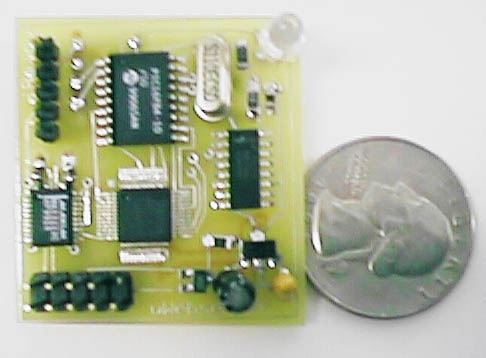
 Shown here is a uWebserver™ board. It
measures 1.3" by 1.5". It could be made much smaller, but besides not taking the
time to optimize for size, I left some bulky headers for in circuit programming and
interfacing. It is a compleat webserver, all items are shown, nothing hidden.
Shown here is a uWebserver™ board. It
measures 1.3" by 1.5". It could be made much smaller, but besides not taking the
time to optimize for size, I left some bulky headers for in circuit programming and
interfacing. It is a compleat webserver, all items are shown, nothing hidden.
The heart of the webserver is the S-7600A chip or iChip from Seiko. The iChip is a LSI that incorporates iReady's patented hardware protocol stack. It offers designers a very easy way to add internet functionality to any project. The iChip contains a very high performance internet statemachine that can operate from 300bps to over T1/E1 speeds while consuming less that 5ma. The iChip is targeted at dialup devices, but different flavors of this chip will be available soon. Look for ethernet, PIAFS, PDC, CDMA-1, and other protocols soon. The iReady technology is also available as a licencable core to embed in almost any custom chip.
Little else besides a micro controller and a modem is needed to get any device on line using the iChip.
The iChip is controlled by a PIC16F84 8-bit micro controller. The driver code to operate the web server is around 100 bytes. The web pages are embedded in the program code space. Extra things like web counters or sensor inputs can take up some more code, but there is more than enough space to develop a webserver that can control and report the status of a device. A Block Diagram shows the hardware layout. Software additions that will allow this device to dialup via modem to any ISP is as simple as adding a few lines of code.
Compleat internet code for many applications weighs in at less thatn 200 bytes of code for many 8 bit mico controllers and takes little CPU time, leaving plenty of code space and MIPS left for your main application.
In the current code uses the internal flash memory of the PIC to store webpages, though support for the serial EEPROM that is on the newer board will happen soon.
The basic concepts shown in this design have many applicable uses, some of the most powerful are email reporting engines, internet paging, moble email machines, internet faxing, voice over internet devices, cell phone web browsers, security surveillance and monitoring, process control equipment, irrigation control and vending machine reporting.
Currently the power consumption is around 5ma (with LED on).
